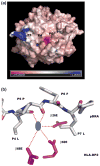Structural basis of metal hypersensitivity
- PMID: 22983897
- PMCID: PMC4040395
- DOI: 10.1007/s12026-012-8351-1
Structural basis of metal hypersensitivity
Abstract
Metal hypersensitivity is a common immune disorder. Human immune systems mount the allergic attacks on metal ions through skin contacts, lung inhalation and metal-containing artificial body implants. The consequences can be simple annoyances to life-threatening systemic illness. Allergic hyper-reactivities to nickel (Ni) and beryllium (Be) are the best-studied human metal hypersensitivities. Ni-contact dermatitis affects 10 % of the human population, whereas Be compounds are the culprits of chronic Be disease (CBD). αβ T cells (T cells) play a crucial role in these hypersensitivity reactions. Metal ions work as haptens and bind to the surface of major histocompatibility complex (MHC) and peptide complex. This modifies the binding surface of MHC and triggers the immune response of T cells. Metal-specific αβ T cell receptors (TCRs) are usually MHC restricted, especially MHC class II (MHCII) restricted. Numerous models have been proposed, yet the mechanisms and molecular basis of metal hypersensitivity remain elusive. Recently, we determined the crystal structures of the Ni and Be presenting human MHCII molecules, HLA-DR52c (DRA*0101, DRB3*0301) and HLA-DP2 (DPA1*0103, DPB1*0201). These structures revealed unusual features of MHCII molecules and shed light on how metal ions are recognized by T cells.
Figures




Similar articles
-
Structural basis of chronic beryllium disease: linking allergic hypersensitivity and autoimmunity.Cell. 2014 Jul 3;158(1):132-42. doi: 10.1016/j.cell.2014.04.048. Cell. 2014. PMID: 24995984 Free PMC article.
-
T cell receptor (TCR) interaction with haptens: metal ions as non-classical haptens.Toxicology. 2005 Apr 15;209(2):101-7. doi: 10.1016/j.tox.2004.12.015. Epub 2005 Jan 23. Toxicology. 2005. PMID: 15767020 Review.
-
The molecular basis of metal recognition by T cells.J Invest Dermatol. 1994 Apr;102(4):398-401. doi: 10.1111/1523-1747.ep12372149. J Invest Dermatol. 1994. PMID: 8151118 Review.
-
Using DR52c/Ni2+ mimotope tetramers to detect Ni2+ reactive CD4+ T cells in patients with joint replacement failure.Toxicol Appl Pharmacol. 2017 Sep 15;331:69-75. doi: 10.1016/j.taap.2017.05.020. Epub 2017 May 26. Toxicol Appl Pharmacol. 2017. PMID: 28554661 Free PMC article.
-
Immunologic mechanisms in hypersensitivity reactions to metal ions: an overview.Allergy. 2000 Feb;55(2):108-15. doi: 10.1034/j.1398-9995.2000.00107.x. Allergy. 2000. PMID: 10726725 Review.
Cited by
-
Nickel allergy to orthopaedic implants: A review and case series.J Clin Orthop Trauma. 2020 Jul;11(Suppl 4):S596-S603. doi: 10.1016/j.jcot.2020.02.008. Epub 2020 Feb 24. J Clin Orthop Trauma. 2020. PMID: 32774035 Free PMC article. Review.
-
Vaccines, adjuvants and autoimmunity.Pharmacol Res. 2015 Oct;100:190-209. doi: 10.1016/j.phrs.2015.08.003. Epub 2015 Aug 12. Pharmacol Res. 2015. PMID: 26275795 Free PMC article. Review.
-
Contact dermatitis.Nat Rev Dis Primers. 2021 May 27;7(1):38. doi: 10.1038/s41572-021-00271-4. Nat Rev Dis Primers. 2021. PMID: 34045488 Review.
-
Disease-associated metabolic pathways affected by heavy metals and metalloid.Toxicol Rep. 2023 Apr 24;10:554-570. doi: 10.1016/j.toxrep.2023.04.010. eCollection 2023. Toxicol Rep. 2023. PMID: 37396849 Free PMC article. Review.
-
Interaction of Materials and Biology in Total Joint Replacement - Successes, Challenges and Future Directions.J Mater Chem B. 2014 Nov 7;2(41):7094-7108. doi: 10.1039/C4TB01005A. J Mater Chem B. 2014. PMID: 25541591 Free PMC article.
References
-
- Budinger L, Hertl M. Immunologic mechanisms in hypersensitivity reactions to metal ions: an overview. Allergy. 2000;55(2):108–15. - PubMed
-
- Schiraldi M, Monestier M. How can a chemical element elicit complex immunopathology? Lessons from mercury-induced autoimmunity. Trends Immunol. 2009;30(10):502–9. - PubMed
-
- Vas J, Monestier M. Immunology of mercury. Ann N Y Acad Sci. 2008;1143:240–67. - PubMed
-
- Rowley B, Monestier M. Mechanisms of heavy metal-induced autoimmunity. Mol Immunol. 2005;42(7):833–8. - PubMed
-
- Li H, Llera A, Malchiodi EL, Mariuzza RA. The structural basis of T cell activation by superantigens. Annu Rev Immunol. 1999;17:435–66. - PubMed
Publication types
MeSH terms
Substances
Grants and funding
LinkOut - more resources
Full Text Sources
Medical
Research Materials

